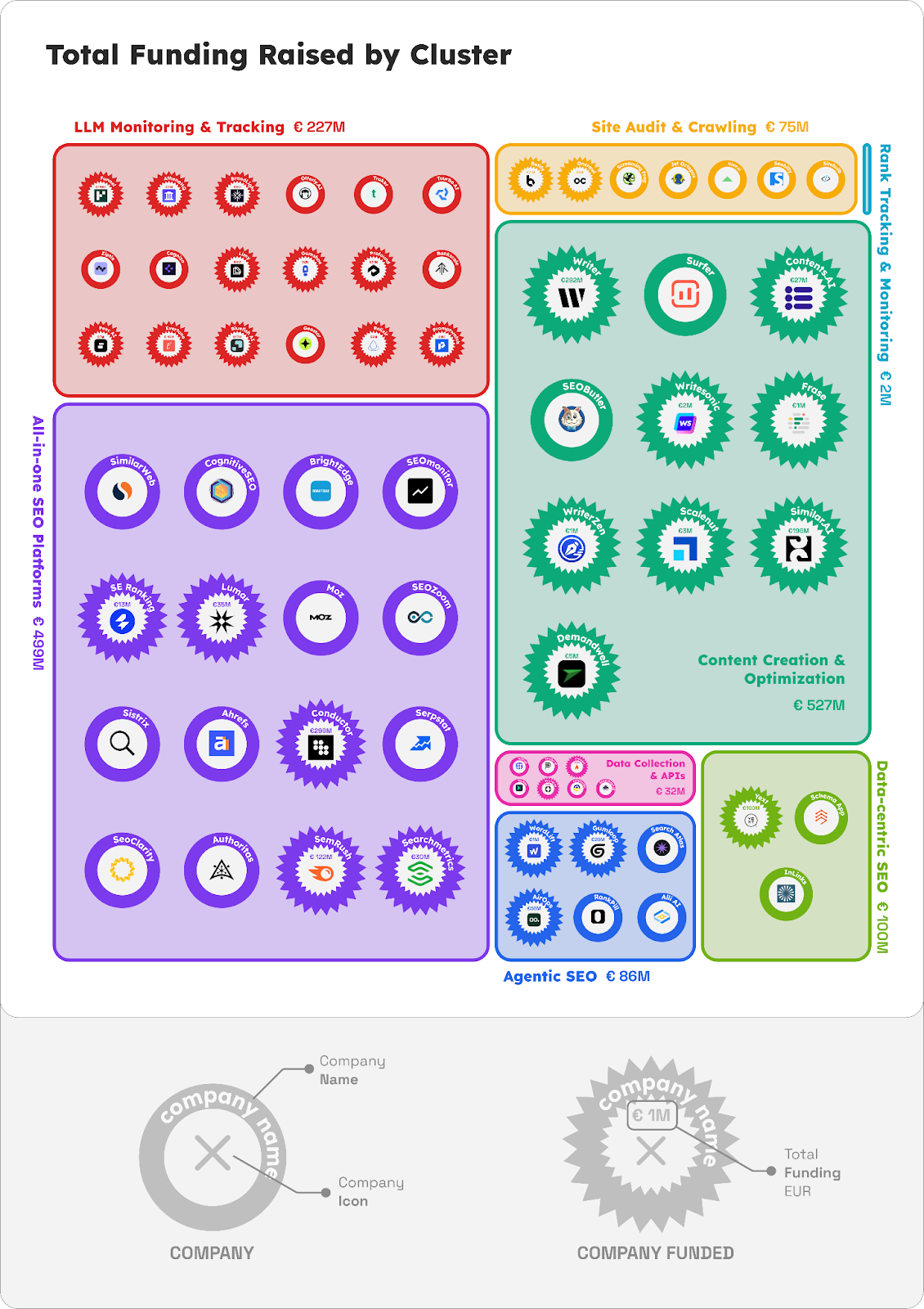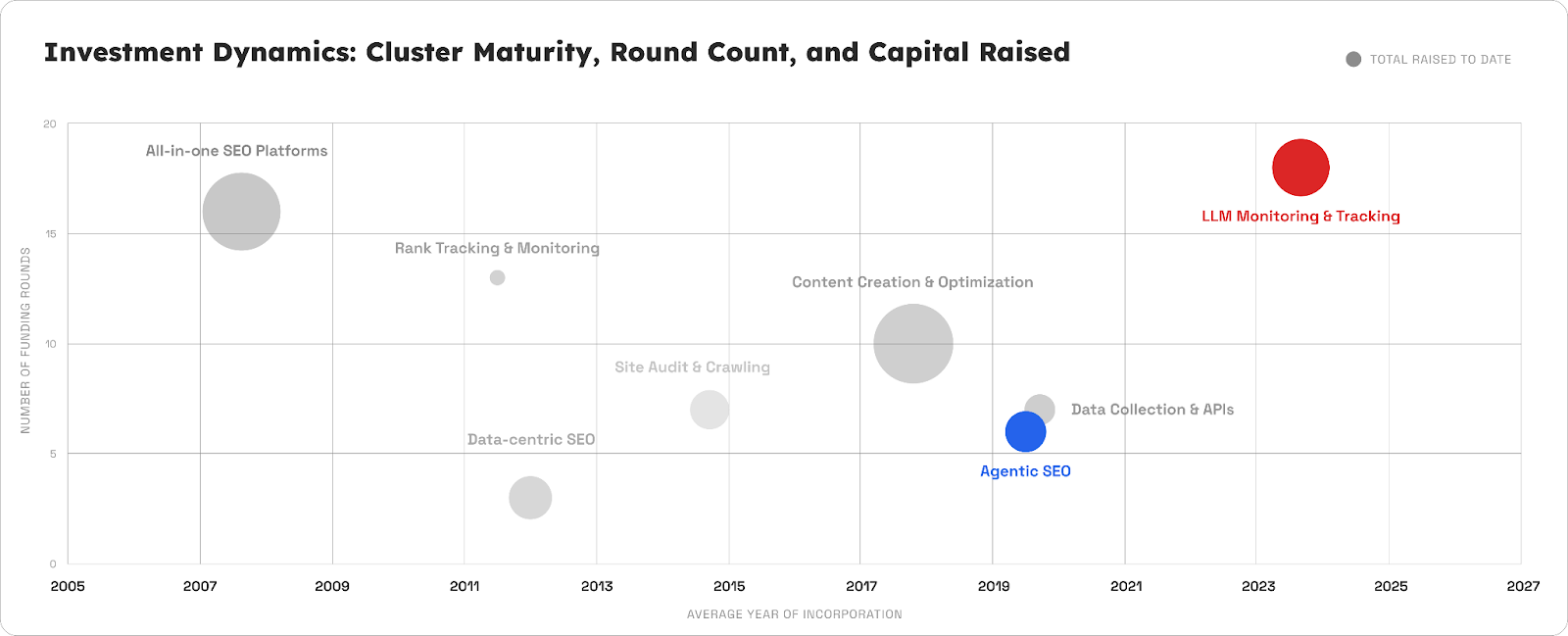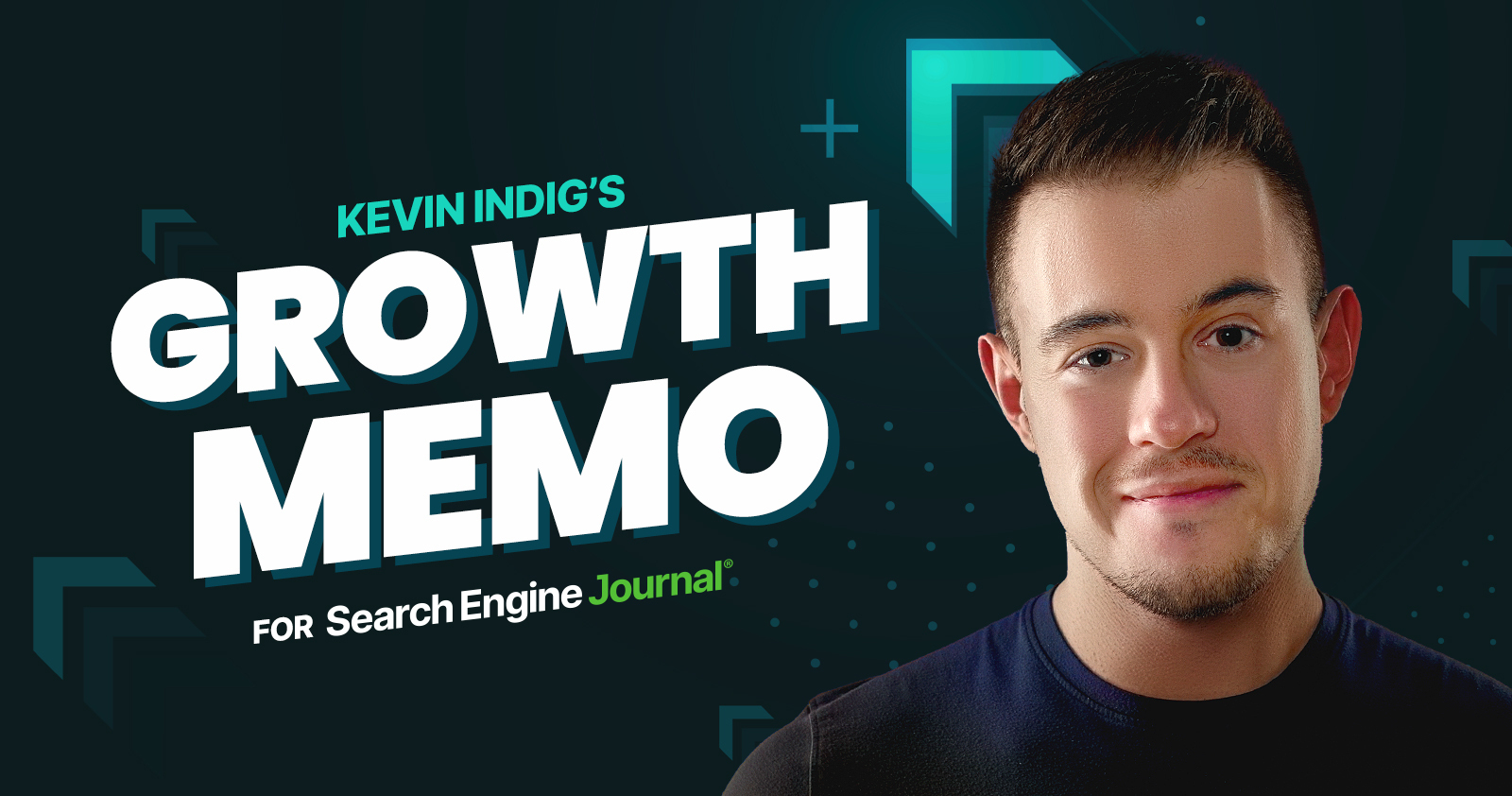Adobe just paid $1.9 billion for Semrush. Not for the LLM tracking dashboards. For the platform, the customer relationships, and the distribution.
Contrast: Investors poured $227 million into AI visibility tracking. Most of that went to tracking dashboards. The companies shipping outputs from agentic SEO raised a third of that. Adobe’s acquisition proves dashboards were never the point.
Investors chased LLM monitoring because it looked like easy SaaS, but the durable value sits in agentic SEO tools that actually ship work. Why? Because agentic SEO goes beyond the traditional SEO tooling setup, and offers SEO professionals and agencies a completely new operational capability that can augment (or doom) their business.
Together with Wordlift, Growth Capital, Niccolo Sanarico, Primo Capital, and G2, I analyzed the funding data and the companies behind it. The pattern is clear: Capital chased what sounded innovative. The real opportunity hid in what actually works.
1. AI Visibility Monitoring Looked Like The Future

We looked at 80 companies and their collective $1.5 billion in venture funding:
- Established platforms (five companies) captured $550 million.
- LLM Monitoring (18 companies) split $227 million.
- Agentic SEO companies got $86 million.
AI visibility tracking seemed like the obvious problem in 2024 because every CMO asked the same question: “How does my brand show up in ChatGPT?” It’s still not a solved problem: We don’t have real user prompts, and responses vary significantly. But measuring is not defensible. The vast number of startups providing the same product proves it.
Monitoring tools have negative switching costs. Agentic tools have high switching costs.
- Low pain: If a brand turns off a monitoring dashboard, they lose historical charts.
- High pain: If a brand turns off an agentic SEO platform, their marketing stops publishing.
Venture capital collectively invested +$200 million because companies care about how and where they show up on the first new channel since Alphabet, Meta, and TikTok. The AI visibility industry has the potential to be bigger than the SEO industry (~$75 billion) because Brand and Product Marketing departments care about AI visibility as well.
What they missed is how fast that trend becomes infrastructure. Amplitude proved it was commoditizable by offering monitoring for free. When Semrush added it as a checkbox, the category collapsed.
2. The Alpha Is In Outcomes, Not Insights
Outcomes trump insights. In 2025, the value of AI is getting things done. Monitoring is table stakes.
73% of AI visibility tracking companies were founded in 2024 and raised $12 million on average. That check size is typically reserved for scale-stage companies with proven market-fit.

Our analysis reveals a massive maturity gap between where capital flowed and where value lives.
- Monitoring companies (average age: 1.3 years) raised seed capital at growth valuations.
- Agentic SEO companies (average age: 5.5 years) have been building infrastructure for nearly a decade.
Despite being more mature, the agentic layer raised one-third as much capital as the monitoring layer. Why? Because investors missed the moat.
Investors dislike “shipping” tools at the seed stage because they require integration, approval workflows, and “human-in-the-loop” setup. To a VC, this looks like low-margin consulting. Monitoring tools look like perfect SaaS: 90% gross margins, instant onboarding, and zero friction.
Money optimized for ease of adoption and missed ease of cancellation.
- The Monitoring Trap: You can turn off a dashboard with a click to save budget.
- The Execution Moat: The “messy” friction of agentic SEO is actually the defensibility. Once an operational workflow is installed, it becomes infrastructure. You cannot turn off an execution engine without halting your revenue.
Capital flowed to the “clean” financials of monitoring, leaving the “messy” but durable execution layer underfunded. That is where the opportunity sits.
Three capabilities separate the winners from the features:
- Execution Velocity: Brands need content shipped across Reddit, TikTok, Quora, and traditional search simultaneously. Winners automate the entire workflow from insight to publication.
- Grounding in Context: Generic optimization loses to systems that understand your specific business logic and brand voice. (Ontology is the new moat).
- Operations at Scale: Content generation without pipeline management is a toy. You need systems enforcing governance across dozens of channels. Point solutions lose; platform plays win.
The difference is simple: one group solves “how do I know?” and the other solves “how do I ship?”
3. The Next 18 Months Will Wipe Out The Weakest Part Of The AI Stack
The market sorts into three tiers based on defensibility:
1. Established platforms win by commoditizing. Semrush and Ahrefs have customer relationships spanning two decades. They’ve already added LLM monitoring as a feature. They now need to move faster on the action layer – the workflow automation that helps marketers create and distribute assets at scale. Their risk isn’t losing relevance. It’s moving too slowly while specialized startups prove out what’s possible.
The challenge: Established platforms are read-optimized; agentic operations require write-access. Semrush and Ahrefs built 20-year moats on indexing the web (Read-Only). Moving to agentic SEO requires them to write back to the customer’s CMS (Write-Access).
2. Agentic SEO platforms scale into the gap. They’re solving real operational constraints with sticky products. AirOps is proving the thesis: $40 million Series B, $225 million valuation. Their product lives in the action layer – content generation, maintenance, rich media automation. Underfunded today, they capture follow-on capital tomorrow.
3. Monitoring tools consolidate or disappear. Standalone AI visibility vendors have 18 months to either build execution layers on top of their dashboards or find an acquirer. The market doesn’t support single-function tracking at venture scale.
Q3/Q4 2026 could be an “Extinction Event.” This is when the 18-month runway from the early 2024 hype cycle runs out. Companies will go to market to raise more money, fail to show the revenue growth required to support their 2024 valuations, and be forced to:
- Accept a “down-round” (raising money at a lower valuation, crushing employee equity).
- Sell for parts (acqui-hire).
- Fold.
Let’s do some basic “Runway Math”:
- Assumption: The dataset shows the average “Last Funding Date” for this cluster is March 2025. This means the bulk of this €227 million hit bank accounts in Q1 2025.
- Data Point: The average company raised ~€21 million.
- The Calculation: A typical Series A/Seed round is calculated to provide 18 to 24 months of runway. With the last funding in Q1 2025 and 18 months of runway, we arrive at Q3 2026.
To raise their next round (Series B) and extend their life, AI visibility companies must justify the high valuation of their previous round. But to justify a Series A valuation (likely $50-$100 million post-money given the AI hype), they need to show roughly 3x-5x ARR growth year-over-year. Because the product is commoditized by free tools like Amplitude and bundled features from Semrush, they might miss that 5x revenue growth target.
Andrea Volpini, Founder and CEO of Wordlift:
After 25 years, the Semantic Web has finally arrived. The idea that agents can reach a shared understanding by exchanging ontologies and even bootstrap new reasoning capabilities is no longer theoretical. It is how the human-centered web is turning into an agentic, reasoning web while most of the industry is caught off guard. When Sir Tim Berners-Lee warns that LLMs may end up consuming the web instead of humans, he is signaling a seismic shift. It is bigger than AI Search. It is reshaping the business model that has powered the web for three decades. This AI Map is meant to show who is laying the foundations of the reasoning web and who is about to be left behind.
4. The Market Thesis: When $166 Billion Meets Behavioral Disruption
From Niccolo Sanarico, writer of The Week in Italian Startups and Partner at Primo Capital:
Let’s leave the funding data for a moment, and shift to the demand side of the market: on the one hand, Google integrating AI search results on its SERP, ChatGPT or Perplexity becoming the entry point for search and discovery, are phenomena that are creating a change in user behavior – and when users change behavior, new giants emerge. On the other hand, SEO has historically been a consulting-like, human-driven, tool-enabled effort, but its components (data monitoring & analysis, content ideation & creation, process automation) are the bread and butter of the current generation of AI, and we believe there is a huge space for emerging AI platforms to chip away at the consulting side of this business. Unsurprisingly, 42% of the companies in our dataset were founded on or after 2020, despite the oldest and greatest players dating back more than 20 years, and the key message they are passing is “let us do the work.”
The numbers validate this thesis at scale. Even though it is not always easy to size it, recent research finds that the SEO market represents a $166 billion opportunity split between tools ($84.94 billion) and services ($81.46 billion), growing at 13%+ annually. But the distribution reveals the disruption opportunity: agencies dominate with 55% market share in services, while 60% of enterprise spend flows to large consulting relationships. This $50+ billion consulting layer – built on manual processes, relationship-dependent expertise, and human-intensive workflows – sits directly in AI’s disruption path.
The workforce data tells the automation story. With >200,000 SEO professionals globally and median salaries in the US of $82,000 (15% above U.S. national average), we’re looking at a knowledge worker category ripe for productivity transformation. The job market shifts already signal this transition: content-focused SEO roles declined 28% in 2024 as AI automation eliminated routine work, while leadership positions grew 50-58% as the focus shifted to strategy and execution oversight. When 90% of new SEO positions come from companies with 250+ employees, and these organizations are simultaneously increasing AI tool budgets from 5% to 15% of total SEO spend, the path forward is clear: AI platforms that can deliver execution velocity will capture the value gap between high-cost consulting and lower-margin monitoring tools.
5. What This Means For You
For Tool Buyers
Stop asking “Is it AI-powered?” Ask instead:
- Does this solve an operational constraint or just give me information? (If it’s information, Semrush will have it free in 18 months.)
- Does this automate a workflow or create new manual work? (Sticky products are deeply integrated. Point solutions require babysitting.)
- Can I get this from my existing platform eventually, or is this defensible? (If an established player can bundle it, they will.)
For Investors
You’re at an inflection point:
- The narrative layer (monitoring) is collapsing in real-time.
- The substance layer (execution) is still underfunded.
- This gap closes fast.
When evaluating opportunities, ask: “What would need to happen for Semrush or Ahrefs to provide this?” If the answer is “not much,” it’s not defensible at venture scale. If they had to rebuild core infrastructure or cannibalize part of their product, you have a moat.
The best signal isn’t which companies are raising capital, but which categories are raising capital despite low defensibility. That’s where you find the upside.
For Builders
Your strategic question isn’t “Which category should I enter?” It’s “How deeply integrated will I be in my customers’ workflows?” If you’re building monitoring tools, you have 18 months. Either build an execution layer on top of your dashboard or optimize for acquisition.
If you’re building execution platforms, defensibility comes from three things:
- Depth of integration in daily workflows
- Required domain expertise
- Operational leverage you provide relative to building in-house
The winning companies are those that solve problems needing continuous domain expertise and cannot be easily copied. Automated workflows that understand brand guidelines, customer segments, and channel-specific best practices aren’t.
Ask yourself: What operational constraint am I solving that requires judgment calls, not just better AI? If the answer is “I’m just generating better content faster,” you’re building a feature. If the answer is “I’m managing complexity across dozens of channels while enforcing consistency,” you’re building a platform.
Full infographic of our analysis:

Boost your skills with Growth Memo’s weekly expert insights. Subscribe for free!
Featured Image: Paulo Bobita/Search Engine Journal


